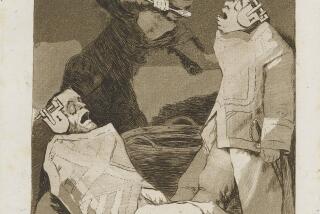Koolhaas’ High-Art Stakes
LAS VEGAS — Can high-end architecture survive amid the glitz of Las Vegas? That is the question raised by Rem Koolhaas’ design for two new art galleries at the Venetian Resort-Hotel-Casino on the Las Vegas Strip.
Unveiled last week by Guggenheim director Thomas Krens under the Venetian’s ornate, gold-encrusted dome, the two gallery designs are radically different in scale and function. The tough, compact Hermitage-Guggenheim Museum is the result of a 2-year-long collaboration between the Russian and New York art institutions. It will exhibit works culled from both collections. At 7,660 square feet, it will flank the main entry of the hotel along the Las Vegas Strip. The Guggenheim Las Vegas, by contrast, is a massive, 7-story-high, 63,700-square-foot exhibition hall that will be built between the casino and the parking structure and will house Guggenheim traveling shows. Both are scheduled to open by next summer.
In Koolhaas’ design, the Venetian complex is conceived as a portal connecting high entertainment and high art. The galleries will fit snugly into their surroundings, but their hard-edged, industrial aesthetic will present an aggressive contrast to the Venetian’s lavish decor. Whether or not they succeed as architecture will go a long way in answering a question that has secretly terrified the profession for more than a decade: How does architecture assert its value in a world saturated by manipulative advertising and mass-market entertainment?
Few architects are better prepared to tackle the problem. Koolhaas has been a cult figure in architecture circles since 1978, when he published “Delirious New York,” a manifesto on Manhattan that argued congestion was the city’s greatest virtue. His most celebrated early work, such as an unbuilt 1993 design for the Jussieu University library in Paris, combined pure, geometric forms, translucent surfaces and sweeping, over-scaled ramps, suggesting a violent collision between the scale of the human being and the scale of the city.
Increasingly, however, Koolhaas has chided the profession’s best thinkers for retreating into an “architectural ghetto”--hiding in the dusty hallways of academia, showing their work in art museums or working for a small cultural elite, rather than engaging the commercial world head on. It is a notion that has meaning beyond the profession. In the Information Age, Koolhaas argues, cultural boundaries--between high and low, art and commerce--will lose their clarity. The answer is direct engagement.
That cool pragmatism has brought him a string of successes. He is now designing three stores for the chic Prada fashion house in New York, San Francisco and Los Angeles. He has won a slew of major competitions, including those for the design of the Seattle Public Library, a student center for the Illinois Institute of Technology in Chicago and a concert hall in Porto, Portugal. The look of his designs has become increasingly aggressive: blunt, often crude forms that reflect the realities of contemporary life rather than a desire for aesthetic purity.
But in many ways, the Las Vegas project is riskier than those earlier commissions. Adding another ostentatious building would be pointless. An architecture that was too refined or too aloof, on the other hand, would come across as pretentious. A neutral space would be swallowed up by the casino without as much as a hiccup.
Koolhaas’ response was to virtually strip his Las Vegas designs of any architecture at all. The Hermitage-Guggenheim, for instance, is a simple rectangular box. Embedded in the Venetian’s facade, it stands just to the left of the main entrance that leads into the hotel-casino. Seven-foot-thick movable walls will allow curators to open up the gallery into one loft-like space or to partition it off into smaller rooms. But it is the material, not the forms, that will give the design its impact. The entire gallery--inside and out--is made of Cor-Ten steel, its surfaces rusted to a soft, orange hue.
The idea is that the velvety surface of the rusted steel will echo the opulent textiles that cover the walls of the real Hermitage’s galleries in St. Petersburg. But the use of raw steel also conforms to a long-held Modernist belief: that buildings should be an expression of their era. The gallery will not be disguised under layers of ornamentation. Its raw beauty reminds us that we live in a post-Industrial Age, not Renaissance or Baroque Venice.
In fact, the steel’s density will recall a bank vault more than a conventional gallery. The walls of the space can be seen as a barrier against the corruption that surrounds the art on all sides. More likely, Koolhaas means them to protect the experience of viewing art, to create a sanctuary devoid of outside intrusions. Or perhaps he is telling us that, if art is to fit seamlessly into the noisy landscape of contemporary life, it will have to develop a thick skin.
*
That same strategy is repeated, on a much larger scale, with the Guggenheim Las Vegas. Despite its size, the gallery will be invisible from the street. Visitors will have to cross the hotel lobby and the casino--with the jingle of slot machines as background noise--before entering the structure via a set of fire doors tucked behind an escalator.
Once, inside, however, the anxious energy of the casino will fade. The gallery recalls the soaring structures of the Industrial Age--an airplane hangar or a factory shed. An enormous, 6-story-tall door will stand at one end of the hall. A “media wall”--with a collage of images projected onto its surface--will cover the other. A long “trench” stretches between the two, covered by glass-and-steel removable floor panels. Escalators lead down to lower galleries and a gift shop.
In effect, the building is a vast machine for transporting and viewing art. The door--which leads to a loading dock outside--can accommodate an 18-wheel tractor-trailer. Above, a movable steel beam supports a crane that can be used to load and unload enormous pieces of artwork.
The crane is only the most obvious in an array of technical gadgetry that is meant to allow curators to constantly reconfigure the space. The transparent floor panels that cover the trench--and weigh 5 tons each--are removable. A grand stair that leads to the lower galleries can also be transformed into a large display area. Up above, a reproduction of Michelangelo’s Sistine Chapel is printed on two enormous mechanical roof panels that can be opened to let in light and air.
But the design stops there. The hall lacks formal complexity or the hierarchy of scale that we associate with high architecture. Its structural details are largely unarticulated. There is no elegant, carefully controlled sequence of spaces. It is as if Koolhaas had decided that those tools could not compete with the sophisticated maze of gambling tables, restaurants and shops of the casino.
Both Koolhaas and Krens have referred to the galleries as authentic space, in contrast to the supposedly inauthentic space of the casino. The pretense of authenticity is silly. Which is truly a more authentic experience--looking at art, or gambling with your last paycheck?
But what the gallery’s presence alongside the casino does create is a new environment of conflicting values. Koolhaas’ art machine is meant as an alternative to Las Vegas’ own machinery of seduction. The openness of the space provides the breathing room for unconstrained thought--a place where one can discard received notions about the culture that surrounds you. Its starkness suggests an unmasking of the hard truths that lie beneath the glitz.
It is a courageous act. And Koolhaas’ hope is clearly that this will lead us to a new understanding of architecture’s cultural role, one that will have more relevance to the world at large. Ultimately, however, architecture and art cannot escape the economics of Las Vegas. With no place to hide, they must survive on their own merits.
As Las Vegas art critic Dave Hickey said on a recent cruise down the Strip, this is not a city that dwells on the past. If Koolhaas’ vision doesn’t sell, it will be ruthlessly discarded.
More to Read
The biggest entertainment stories
Get our big stories about Hollywood, film, television, music, arts, culture and more right in your inbox as soon as they publish.
You may occasionally receive promotional content from the Los Angeles Times.










